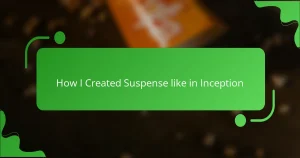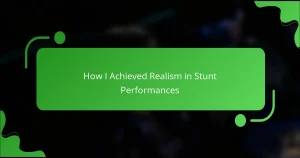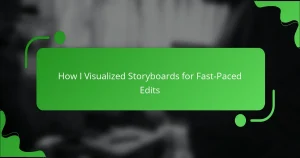Key takeaways
- Camera angles significantly influence the emotional tone and storytelling in action short films, impacting viewer engagement.
- Low-angle shots convey power and dominance, while high-angle shots evoke vulnerability and empathy.
- Close-ups intensify emotional connections, allowing audiences to resonate deeply with characters’ feelings and struggles.
- Dynamic angle choices enhance tension and excitement, making action sequences more gripping and immersive.
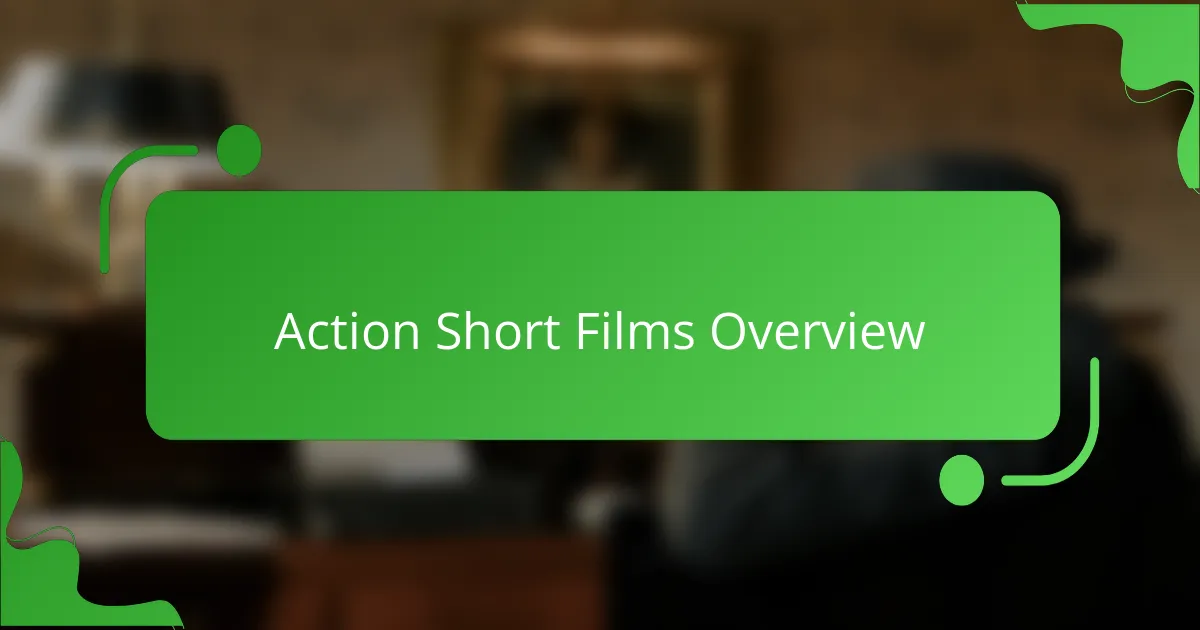
Action Short Films Overview
Action short films are a dynamic and engaging genre that often pack a punch in a brief runtime. I’ve always been fascinated by how these films utilize limited time to build tension and excitement, often leaving viewers wanting more. The challenge of conveying a gripping narrative with fast-paced action is something that requires skillful filmmaking techniques.
One critical aspect that influences the storytelling of action short films is the camera angle. Using different angles can drastically change the viewer’s perception of a scene. For example, a low-angle shot can make a character appear more powerful, while a high-angle shot might convey vulnerability. As a viewer, I feel these choices significantly enhance the emotional impact and overall effectiveness of a scene.
Here’s a comparison of various camera angles commonly used in action short films, highlighting their effects and emotional resonance:
| Camera Angle | Effect/Emotion |
|---|---|
| Low-Angle | Conveys power and dominance |
| High-Angle | Indicates weakness or vulnerability |
| Close-Up | Emphasizes emotion and detail |
| Over-the-Shoulder | Creates intimacy or tension |
| Bird’s Eye View | Gives a sense of scale and context |
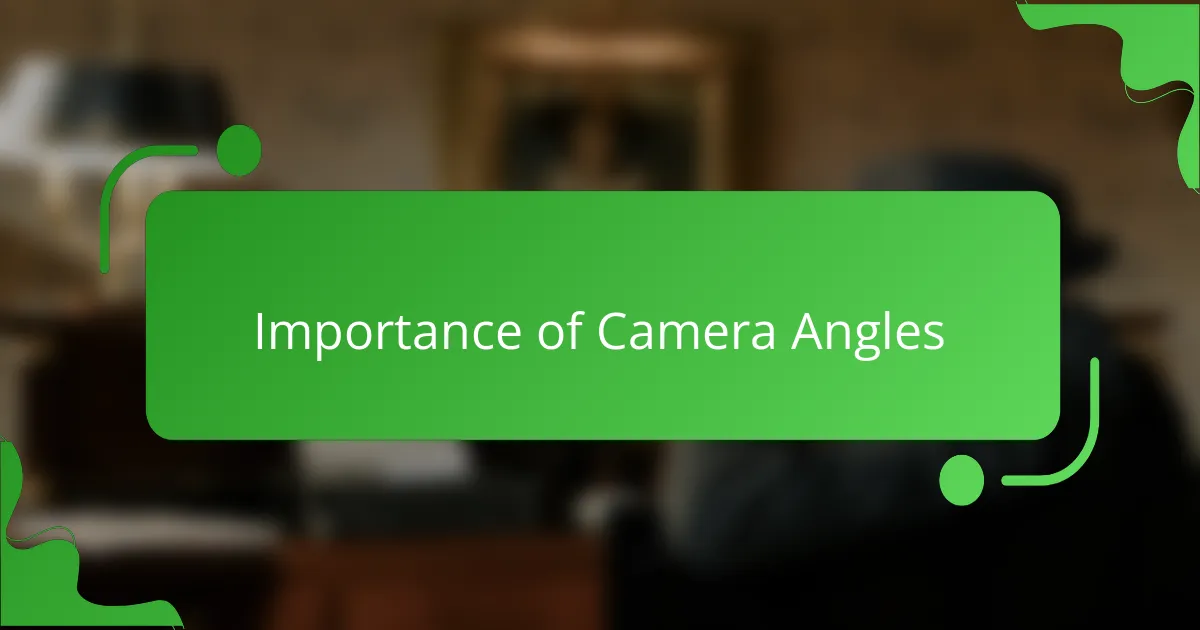
Importance of Camera Angles
Camera angles play a crucial role in shaping the viewer’s experience, especially in action films like “Die Hard.” The choice of a low angle can make a character appear more powerful and imposing, creating a sense of tension, whereas a high angle might evoke vulnerability. I recall the first time I noticed an extreme close-up of John McClane as he contemplates his next move; it drew me into his anxiety, making me feel his desperation and determination.
Different camera angles can also heighten the stakes of a scene, immersing the audience in the action. For example, when the camera shifts to a wide shot during a chaotic shootout, it allows viewers to see the scale and danger of the moment. Reflecting on my own experience as a filmmaker, I understand how the right angle can transform an ordinary sequence into gripping visual storytelling.
- Camera angles influence emotional tone: A high angle can induce fear, while a low angle instills confidence.
- Dynamic angles capture action: Tilted shots can create a disorienting effect, enhancing excitement.
- Perspective enhances narrative: Switching angles can reveal character relationships and motivations.
- Close-ups amplify emotions: They allow audiences to connect deeply with a character’s feelings and reactions.
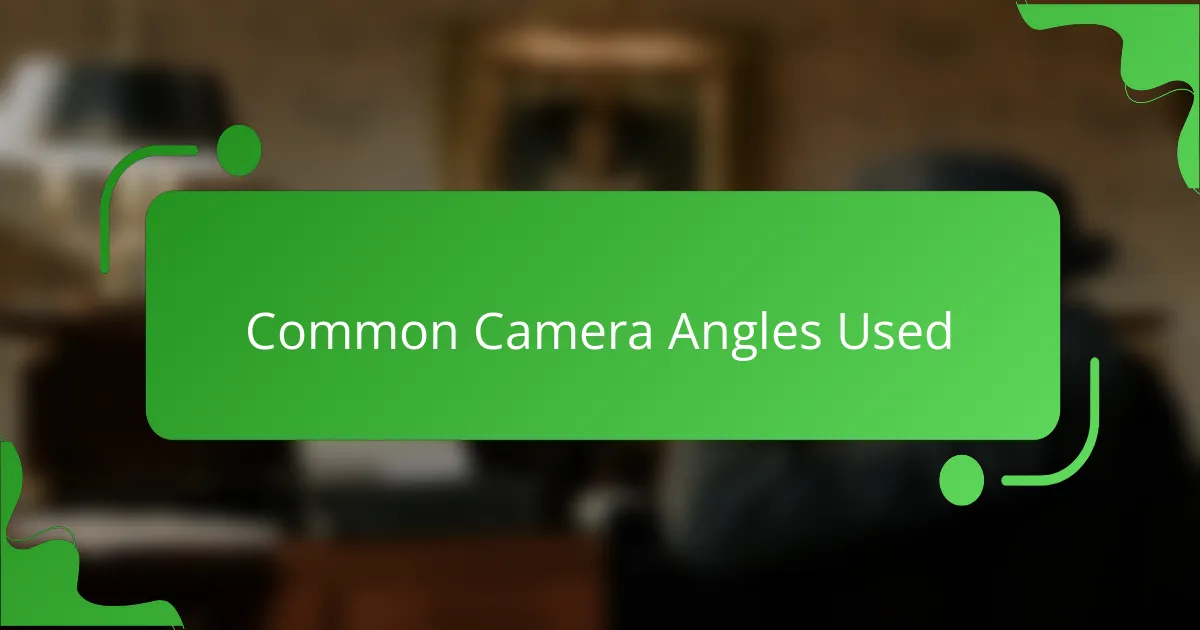
Common Camera Angles Used
When discussing common camera angles, I often reflect on how each choice can shape the story being told. The low-angle shot is a favorite of mine; it not only gives characters like John McClane an imposing presence but also makes moments of triumph more exhilarating. I remember feeling a rush of adrenaline during those pivotal scenes, as if I too were standing tall alongside him, empowered by the framing.
Conversely, the high-angle shot holds its own power—in a way, it invites empathy. I could almost feel McClane’s vulnerability in those tense moments when his situation seemed hopeless. It’s fascinating how just a slight tilt of the camera can shift my feelings from excitement to concern. Have you ever noticed how these angles manipulate your emotions? It’s like a secret language of cinema that speaks directly to the heart.
Close-ups are another staple that I truly appreciate. They draw me into a character’s emotional landscape, making me feel their pain or determination up close. I’ll never forget a close-up shot of McClane’s sweat-drenched face during a particularly harrowing escape; it felt intimate, raw, and undeniably powerful. It showcases how a well-placed camera angle can create a connection that resonates long after the credits roll.
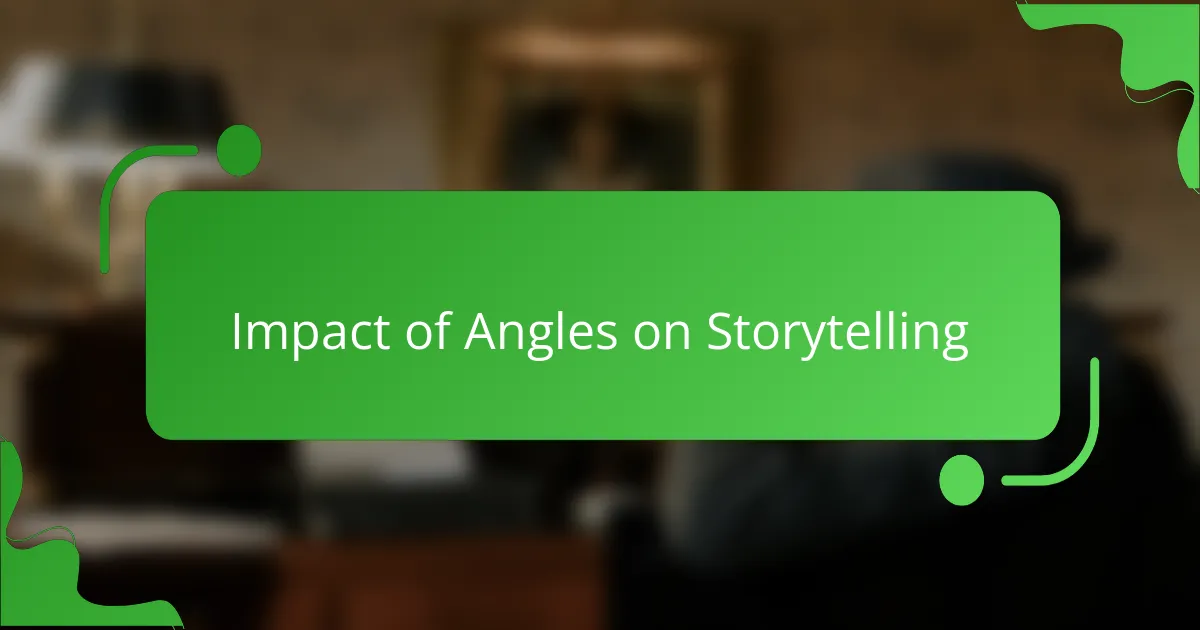
Impact of Angles on Storytelling
The impact of camera angles on storytelling is profound, especially in how they guide our emotional responses. I remember watching a low-angle shot during an intense standoff in “Die Hard.” It didn’t just highlight John McClane’s grit; it made me feel an adrenaline rush, as if I were almost ready to fight alongside him. Isn’t it remarkable how that change in perspective can elevate the stakes?
Then there are those moments when a high-angle shot captures vulnerability, forcing us to empathize with the character’s plight. I can think back to scenes where McClane appears small and isolated amidst chaos. It’s almost as if the camera is whispering, “Look at his struggle,” pulling me into his despair and making his eventual triumph even more satisfying. Do you ever notice how these shifts in angle create a narrative rhythm that keeps you engaged?
Close-ups are equally compelling. They zoom in on a character’s emotions, stripping away distractions and daring you to feel what they feel. I once watched a scene where the camera lingered on McClane’s face as he processed his choices, and I found myself holding my breath, feeling his inner turmoil. It emphasizes a crucial point: these angles are not just technical choices; they’re emotional tools that breathe life into the story. How do you think camera angles shape your understanding of characters and their journeys?
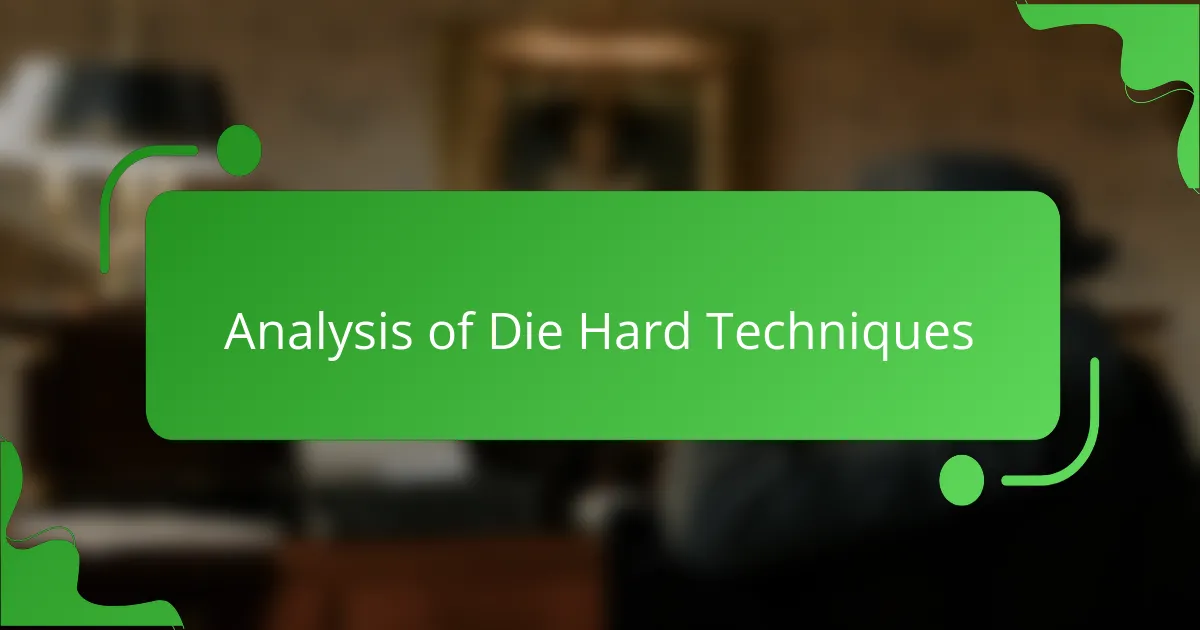
Analysis of Die Hard Techniques
In analyzing the techniques used in “Die Hard,” it’s fascinating how the camera angles not only establish the action but also heighten the emotional stakes. I remember the first time I saw John McClane crawling through the vents; the tight shots made me feel his desperation and fear. This use of tight framing is a powerful tool in action films, creating claustrophobia that immerses viewers into the character’s experience.
On the other hand, the sweeping shots of the Nakatomi Plaza contribute a sense of scale to the chaos. These angles emphasize the towering heights and vast spaces, contrasting sharply with the intimate close-ups of McClane’s struggles. It’s a brilliant way to make the audience feel the magnitude of his fight against overwhelming odds.
- The use of tight framing to convey urgency and desperation.
- High-angle shots that establish the vastness of Nakatomi Plaza.
- Dutch angles that create disorientation during intense moments.
- Wide shots to showcase action sequences, enhancing the thrill.
- Strategic close-ups to highlight character emotions and reactions.
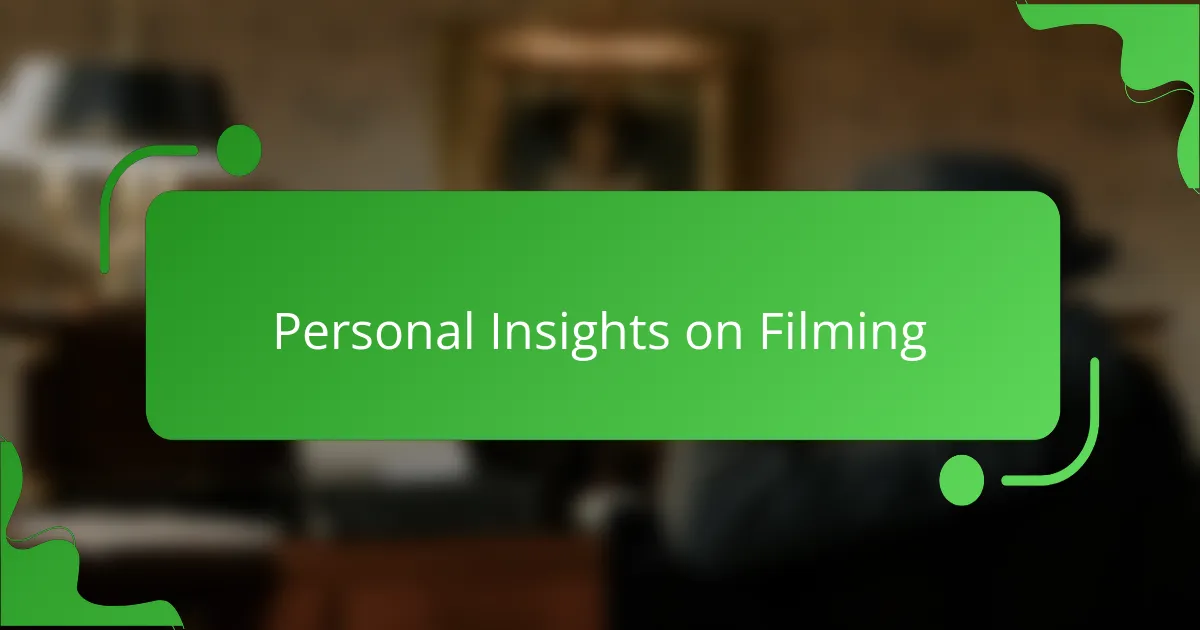
Personal Insights on Filming
When it comes to filming action sequences, camera angles play a crucial role in conveying emotion and tension. In “Die Hard,” for instance, the use of low angles during intense moments makes characters look more powerful and menacing, while high angles can create a sense of vulnerability. I still remember the thrill of watching John McClane ascend those skyscraper shafts. The way the camera captures the dizzying heights not only adds to the suspense but also makes you feel as if you’re right there with him.
Using close-ups during critical dialogue exchanges enhances the emotional stakes, pulling the viewer deeper into the story. I find myself hooked every time McClane’s desperation is mirrored in those tight shots. It’s fascinating how a well-placed camera angle can dramatically shift the audience’s perception and investment in the scene.
| Camera Angle | Effect in Die Hard |
|---|---|
| Low Angle | Portrays strength and authority |
| High Angle | Evokes vulnerability |
| Close-Up | Intensifies emotional connection |
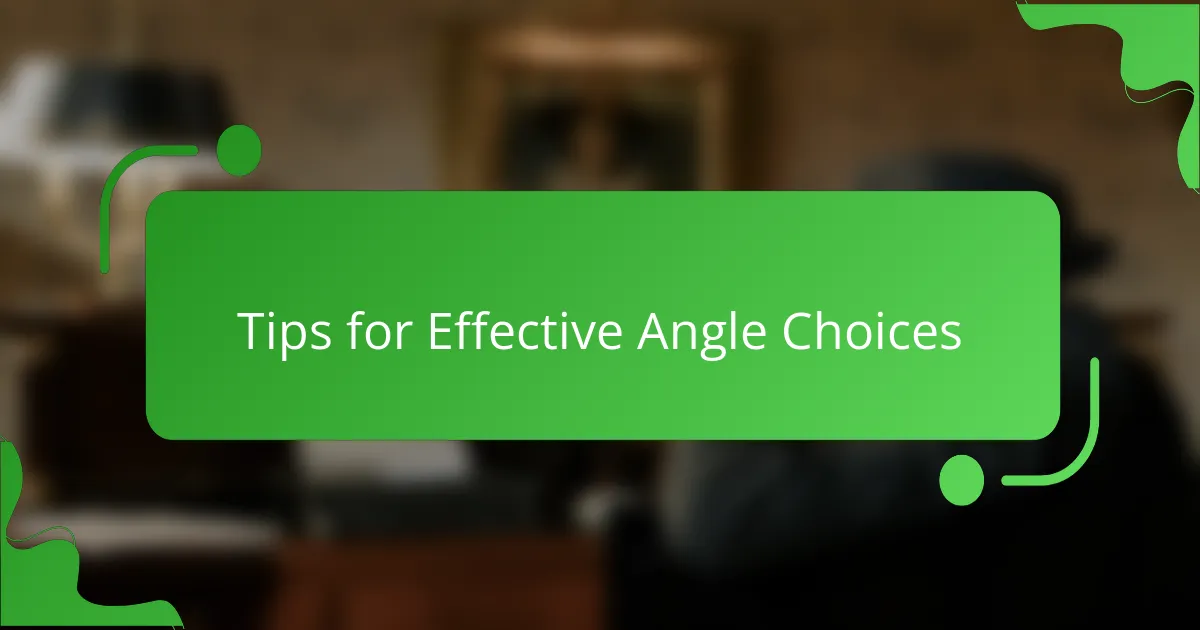
Tips for Effective Angle Choices
When considering camera angles for your action short films, think about how each shot can enhance the story. For example, using low angles can make characters appear more powerful and dominant, while high angles can evoke a sense of vulnerability. I recall a scene I shot where a low angle made the protagonist seem larger than life, leaving the audience in awe.
Incorporating dynamic angles can also build tension. Quick cuts between different perspectives keep the viewers on the edge of their seats. Once, I experimented with close-up shots during a chase scene, showing the characters’ emotions in each moment, which really resonated with the audience.
Here’s a simple comparison table to help you visualize the impact of different angles:
| Camera Angle | Effect |
|---|---|
| Low Angle | Conveys power or aggression |
| High Angle | Evokes vulnerability or defeat |
| Close-Up | Highlights emotions |
| Wide Shot | Establishes context and action space |
